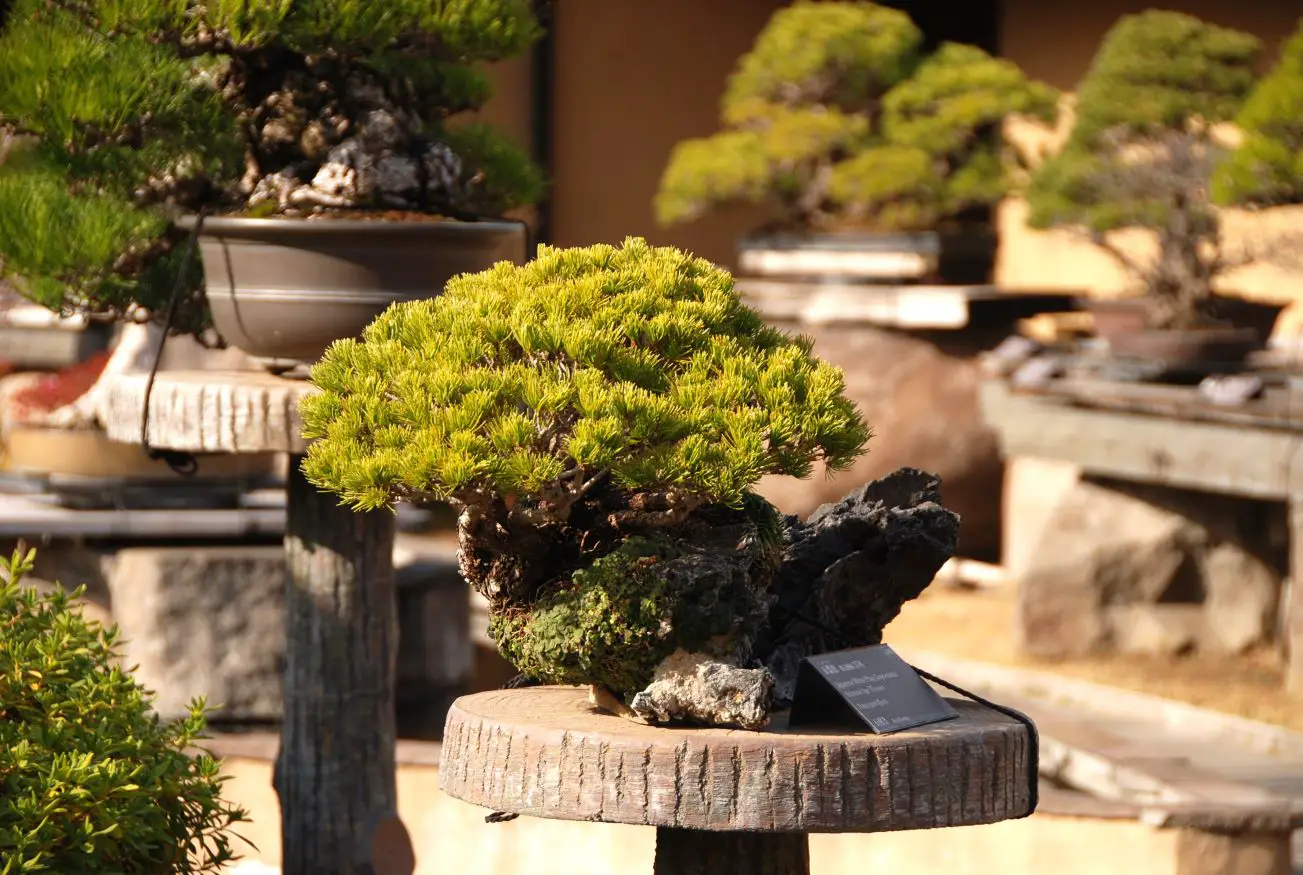Rock bonsai care
Types of rock bonsai
There are two types of rock bonsai styles and each one may need different care:
- Planting and attaching tree(s) to a rock without using a pot, and
- Planting a tree in a pot with a rock, with the roots wrapping around and crawling down the stone into the pot.
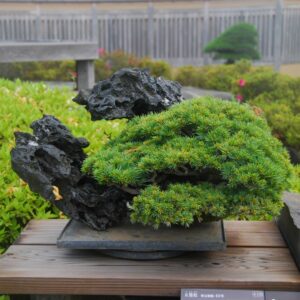
Bonsai on rock style (1)
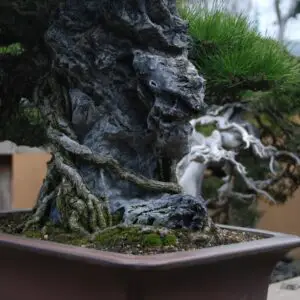
Root over rock style (2)
In this blog post, I’m going to call the first type “bonsai on rock”, and the second type “root over rock bonsai”.
To know more about rock bonsai in general, please read the following post.
Placing
The placement of rock bonsai varies based on the specific tree species planted on the rock.
Sunlight
Different tree species have varying requirements for light but most bonsai tree species grow and thrive best in open places and cannot withstand a long period of time in the full shade.
So in general, your rock bonsai should be kept outside with plenty of sunlight.
Note that some trees (like most coniferous trees) thrive in full sun while others prefer partial shade (like camellia). Place your rock bonsai in a location that provides an appropriate amount of sunlight for the particular tree species involved.
Airflow
Airflow is another consideration to keep in mind. Your bonsai trees need carbon dioxide and oxygen to survive. Stagnant air can lead to fungal diseases and poor overall growth.
Make sure your chosen place allows for sufficient air circulation around the leaves and branches of your rock bonsai. It is always best to avoid placing bonsai trees in enclosed spaces or areas with limited airflow.
Watering
Proper watering is crucial for the health and longevity of your rock bonsai. Watering a rock bonsai is no different from watering any bonsai trees. Misting is a good idea to keep adequate moisture for roots and moss when the rock gets warm with sunlight.
Watering bonsai on rock

Bonsai on rock style: Attaching trees to a rock without a pot
The soil in bonsai on rock, whose roots are NOT planted in pots, dries out very quickly because there is not much soil. On top of that, the rock absorbs heat in the warmer seasons, causing the water in the soil to evaporate easily. If the soil dries out completely, the tree will wither and the soil may start to separate from the rock.
The difficult part is, it can be hard to tell how dry the soil is when there is moss covering all the soil surface.
That’s why it’s important to always check the moisture level of the soil by observing the leaves regularly. Before the soil becomes completely dry, make sure to water thoroughly and abundantly not only the branches, leaves and roots but also the rock, moss and small ornamental plants, if any.
Sometimes, one round of watering may not be enough. In that case, it is better to water again after a while.
You can also put water in a tray and place your rock bonsai in it. The rock absorbs water, supplying enough moisture for your trees and moss.
One thing to keep in mind, though, is that the soil may always be wet if the rock is porous and absorbs too much water, which can lead to root rot. So, it’s important to check the type of rock and be careful whether the moisture level is adequate or not.
Watering root over rock

Root over rock style: Planting a tree in a pot with the roots wrapping around a rock
Watering a root over rock bonsai is basically similar to watering other bonsai as its roots are planted in pots. But it’s important to pay extra attention to the roots and moss attached to the rock. They can dry out much quicker than the soil in the pot when the rock gets warm.
When watering, make sure to give enough water not only to the soil in the pot but also to the rock and moss.
Look out for the roots that are newly attached to the rock. They can wither and die if they dry out and you don’t want that because it is one of the important aesthetics of your rock bonsai. So it’s important to be cautious.
Water your bonsai abundantly until the roots become stronger and can handle periods without much water. This usually takes 2-3 years after the tree is attached to the rock.
Misting
Misting can be a good way to provide water to rock bonsai, especially when hydrating the moss or ornamental plants growing on the rocks. Misting helps create an adequate humidity that settles on the foliage and moss. It can be particularly useful in dry or arid environments like urban apartment balconies.
When misting your rock bonsai, make sure that you cover the leaves, branches, roots, and moss thoroughly. Use a fine misting spray bottle to create a gentle spray.
It is important to note that misting alone may not be sufficient to meet all the water needs of your rock bonsai. Misting should be supplemental to regular watering to ensure the entire root system receives adequate moisture.
The following article shows a general guideline for watering bonsai trees. If you are interested, please check the link below.
Fertilizing
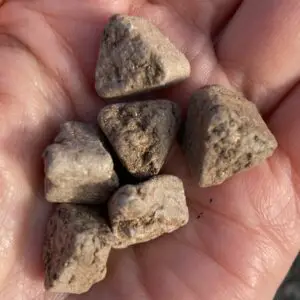
BioGold Bonsai fertilizer
Proper fertilization provides the necessary nutrients for the growth of your rock bonsai. By their form, there are two types of fertilizers for bonsai trees, solid and liquid, and both can be used for rock bonsai.
Fertilizing bonsai on rock
Applying liquid fertilizer is way easier when fertilizing trees in bonsai on rock style because it can be given just like watering trees.
Applying solid fertilizer for bonsai on rock can be a bit challenging though it’s still possible.
If the surface of the soil is flat and the fertilizer will not be washed away when you water the tree, you can top-dress the fertilizer by putting it on top of the soil. If not, you can pin the fertilizer pellets into the soil using wire, or place them in a special container designed for bonsai fertilizers.
(Link to Amazon)
If there is enough soil and the fertilizer won’t directly touch the roots, you can bury the fertilizer in the soil as well.
Fertilizing root over rock
Fertilizing root over rock bonsai is the same as any bonsai tree: apply it to the soil. Choose slow-release fertilizers, preferably in pellets and not granular. Avoid using fast-acting inorganic and/or liquid fertilizers.
Your moss does not need fertilizers. It can live with small amounts of nutrients in water. In fact, ordinary fertilizers for bonsai trees are too strong for moss and it can burn and turn brown if it is in direct contact with them.
If you are wondering which fertilizer is best suited for your rock bonsai, the following article might be helpful.
Styling/Wiring
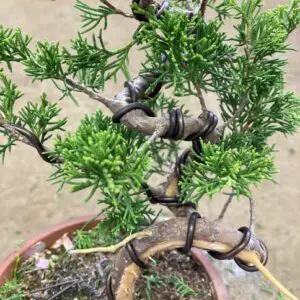
Juniper bonsai styling
It is best to avoid hard pruning and wiring just after making rock bonsai. Removing the tree out of the pot and attaching it to a rock is a very stressful process. Adding another stress may well weaken your tree.
Allow your trees time to recover from the process of being attached to the rock. Wait for a year until they have had a chance to settle and show signs of new growth before engaging in extensive pruning or wiring. Focus on basic pruning during the early stages of a rock bonsai’s development.
Once the trees have demonstrated signs of vigor in the next season, you can start pruning and wiring to shape and refine the rock bonsai. But it is a good idea to take a cautious approach to minimize stress on the trees. Growing on the rock is a very unusual environment for them and reducing stress maximizes their chances of long-term health and longevity.
Repotting
Repotting bonsai on rock

Bonsai on rock style (1)
Traditional repotting as done with potted bonsai is generally not necessary if your trees are planted directly on the rock without using a bonsai pot. Since the trees are planted in a small dent in the rock, the root system has very little space or almost none to expand and grow.
That said, if you notice the soil has been washed away, try putting some more so that your trees have enough soil for moisture retention and access to nutrients.
Repotting root over rock

Root over rock style (2)
Just as with potted bonsai trees, repotting is necessary if the tips of the tree’s roots are planted in a bonsai pot. It is an essential aspect of root over rock bonsai care to refresh the soil and stimulate root growth.
All processes are the same as normal bonsai trees. But one thing to keep in mind is that you should not do hard pruning on the roots of root-over-rock bonsai. If you do, the roots wrapped around the rock tend to come loose.
Preventing infestation
Preventing infestation for rock bonsai is similar to preventing infestation in other bonsai trees. The principles and practices for pest prevention remain largely the same.
Regular checks and maintenance are crucial. Consider using pesticides/fungicides for preventive measures as it is way easier than treating or eradicating pests/diseases once they occur.
For detailed information on how to prevent infestation, the following article might be helpful.
Special seasonal care
Summer
During summer, your rock bonsai needs special protection from the excessive heat that might be absorbed by the rock. Depending on the type of rock, it can absorb too much heat for your bonsai trees or will not let go of the heat accumulated during the day at night. This may cause thermal fatigue and can kill the roots or trees if it gets too hot.
To prevent overheating, shield your rock bonsai from intense sunlight by providing shade during the hottest parts of the day. Use shade cloth or place your rock bonsai under a tree, or move it to a location with filtered sunlight.
Also, increase the frequency of watering to compensate for the higher evaporation rate. Your moss on the rock needs extra moisture under hot climates.
Winter
Generally, your rock bonsai does not need special protection from the cold if other potted bonsai trees do not need it. That said, newly created rock bonsai is susceptible to cold damage, especially when roots are exposed over the rock.
They don’t need a greenhouse or dedicated cold protection facility. Just move your rock bonsai to a sheltered location such as in the garage or shed, or cover it with a shade cloth.

